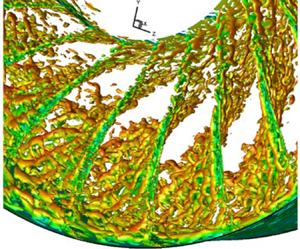Article contents
Spiral flow instability between a rotor and a stator in high-speed turbomachinery and its relation to fan noise
Published online by Cambridge University Press: 26 June 2023
Abstract

Hydrodynamic instabilities in the interstage of turbomachinery and their relation to fan broadband noise are investigated over wide operating conditions. By applying compressible linear stability analysis to the velocity profiles of NASA's high-speed fan rig, source diagnostic test (SDT), three distinct unstable regimes are found: the first mode amplifies disturbances over a wide frequency range including the rotor speed. The second mode rotates much slower and develops inside the outer-wall boundary layer. The third mode spins in the opposite direction. An approach equivalent to dynamic mode decomposition (DMD) successfully extracts these modes from a database of improved delayed detached-eddy simulation (IDDES) solving the SDT geometry at approach and cut-back conditions: the extracted DMD modes generally capture the characteristics of eigenfunctions predicted by the linear stability analysis. At the approach condition, the first two unstable modes seem to interact inside the outer-wall boundary layer, while at the cut-back condition, disturbances associated with the first regime migrate away from the wall. Moreover, outer-wall pressure fluctuations of the IDDES database are Fourier decomposed in the interstage: coherent structures extracted using proper orthogonal decomposition are found to be dominated by duct acoustic modes, and they can be mapped not only to interaction tones but also to broadband noise likely associated with the interaction between disturbances in the rotor wakes and quasi-stationary structures near the outer wall. This interaction noise appears to be radiated to both inlet and exhaust with similar azimuthal-mode distributions; however, the importance relative to other noise sources decreases with the engine speed.
JFM classification
- Type
- JFM Papers
- Information
- Copyright
- © The Boeing Company, 2023. Published by Cambridge University Press
References
- 2
- Cited by



